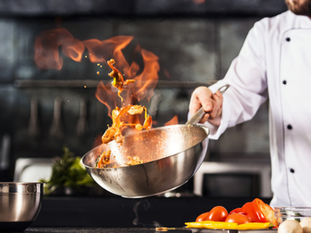
The Truth About Non Stick Pans: When to Replace Yours (It’s Sooner Than You Think!)
0
0
0
No-stick pans have transformed the cooking experience. They make cooking healthier with less oil and simplify cleanup. However, many people may overlook the need to replace these useful tools. In this article, we'll discuss the health risks linked to aging non-stick pans, when to consider replacing them, and how to choose a durable option that suits your cooking needs and budget.
Understanding Non-Stick Cookware

Non-stick cookware features a surface that repels food, using materials like Teflon (PTFE) or ceramic coatings. These surfaces allow for efficient cooking and cleaning. However, after frequent use, the non-stick coating can wear down. This wear can lead to food sticking and poses potential health risks.
Health Risks of Worn Non-Stick Pans
Using old or damaged non-stick pans can lead to serious health problems. Many people use these pans regularly, but few realize that deteriorating coatings could let harmful substances seep into food.
For example, studies have found that when non-stick cookware is heated to high temperatures, it may release chemicals like PFOA (perfluorooctanoic acid). Although modern pans are largely PFOA-free, older models might still contain this harmful chemical. Long-term exposure could result in health issues such as:
Hormone Disruption: Chemicals from damaged coatings may interfere with hormone regulation in the body.
Toxic Fumes: Overheated non-stick pans can release fumes that may cause flu-like symptoms in humans and pose dangers to pets like birds.
Ingestion of Particles: Scratched or flaking coatings could lead to tiny particles entering your diet, which may raise health concerns.
Research shows that expectant mothers exposed to PFOA have a 5 to 10% higher risk of their child being born with developmental issues. Thus, replacing non-stick cookware contributes not just to cooking efficiency but is vital for protecting your health.
Signs It's Time to Replace Your Non-Stick Pans
Pay attention to these signs that indicate your non-stick cookware may need to be replaced:
Scratches and Chipping: Noticeable scratches, chips, or dents mean the coating is damaged. This impacts performance and raises concerns about ingestion of harmful particles.
Food Sticking: If you find more food sticking to your skillet, this may signal that the coating is deteriorating. Adding extra oil to prevent sticking may indicate it's time to purchase a new pan.
Discoloration: Heat can cause discoloration over time. If your pans aren't their original color, it's often a sign that their non-stick properties are weakening.
Age of the Pans: Most non-stick cookware lasts around five years. If yours are older, closely evaluate their condition and consider getting replacements.
Manufacturer's Guidelines: Check the manufacturer's guidelines which often provide recommendations on when to replace their products based on average use.
What to Look for When Shopping for Non-Stick Cookware
Finding a durable non-stick pan involves several vital factors. Choosing the right cookware improves your cooking experience and helps you avoid potential risks from inferior options.
Material Matters
Teflon (PTFE): Select PFOA-free pans with a high-quality PTFE coating. These are generally safe for everyday cooking at lower temperatures.
Ceramic Coatings: Increasingly popular, ceramic-coated pans are free from toxic chemicals and can handle higher cooking temperatures, but they might not last as long as Teflon pans.
Durability and Construction
To ensure durability, invest in quality non-stick cookware. Look for:
Heavy-Gauge Materials: Opt for pans made from heavy-gauge aluminum or stainless steel for enhanced heat distribution and longer life.
Thick, Even Coating: Ensure the non-stick layer is thick enough to withstand daily use. Thinner coatings may wear away quickly.
Heat Resistance
Not all non-stick pans can tolerate high heat. Choose cookware that can withstand temperatures of at least 500°F. This tolerance allows for a wider variety of cooking methods and helps protect the coating from damage.
Ergonomic Features
Comfort and ease of use are essential when selecting new non-stick frying pans. Look for pans with:
Comfortable Handles: Ensure handles are heat-resistant and ergonomic to prevent burns or discomfort while cooking.
Helper Handles: For larger pans, a helper handle can simplify lifting and maneuvering, especially when full.
Price Expectations for Quality Non-Stick Cookware
Price ranges for non-stick pots and pans vary greatly depending on material, brand, and features:
Budget Options ($20 - $50): These may offer initial convenience but generally lack durability. Suitable for beginners or occasional use.
Mid-Range ($50 - $100): Typically provide sturdier construction and better heat resistance. Great for dedicated home cooks looking for reliability without overspending.
Premium Brands ($100 and above): These high-end options often feature advanced coatings, superior materials, and warranties. They represent a long-term investment, especially for regular non-stick users.
Investing in quality non-stick cookware contributes to a healthier cooking environment and enhances your enjoyment in the kitchen.
Prioritizing Your Cooking Safety
Understanding the importance of replacing non-stick cookware and recognizing the related health risks is crucial for everyone who loves to cook. Keeping an eye on the condition of your pans and considering quality attributes while shopping will help ensure a safe cooking experience.
The right non-stick cookware can elevate your culinary skills and bring peace of mind. Don't wait for your pans to deteriorate beyond repair. Make informed decisions that benefit your health as you enjoy cooking. Happy cooking!










